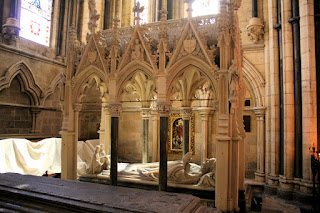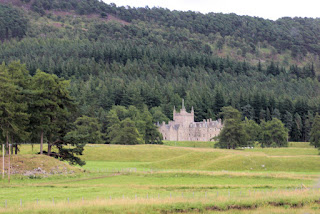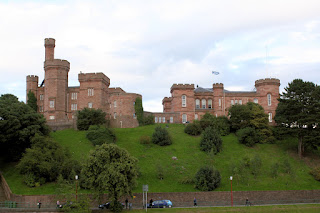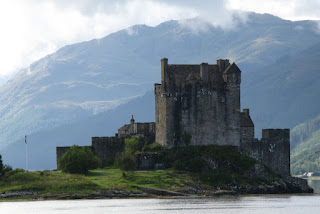The Stonehenge landscape is a World Heritage Site (1986) and protected by the National Trust. The Stonehenge monument is under management of the English Heritage.
Sunday, October 17, 2010
Saturday, October 9, 2010
EIS - The Giant's Causeway
Giant's Causeway
From the visitor center for the Giant's Causeway, you must either walk a mile down and around the corner to the sea or take one of the shuttles (which cost £1 each way). We walked, and just below the visitor center is a group of rocks below the cliff which is called the camel hump, as you can see.
When we got to the bottom of the roadway, we went on the back side of the hill. As you can see the basalt columns here are quite tall, about 25-30 feet high.
The Giants Causeway, in Northern Ireland, has remarkable geological features formed by volcanic activity and cooling lava. The columnar basalt is a unique formation and the sea level location where the tops form a walkway, makes it an exceptional feature.
It earned the title of the eighth wonder of the world. First documented in 1693, the Causeway and cliffs of the Causeway coast have attracted thousands of visitors.
The myth says that the famous Irish giant, Finn MacCool, built it. Finn lived on the north coast of Ireland and had a rivalry with the giant, Benandonner, in Scotland. The two had words across the sea boasting about their fighting ability and after Finn threw a rock as a challenge, Benandonner threw one back saying he could not swim. Finn then tore slabs of volcanic rock from the land to pave a causeway.
 When Benandonner got to the house, Finn's wife said that he wasn't home and to not bother his baby since he was sleeping. Benandonner saw how big "Finn's baby" was and imagined how big Finn really was and went running back to Scotland, tearing up the causeway as he went.
When Benandonner got to the house, Finn's wife said that he wasn't home and to not bother his baby since he was sleeping. Benandonner saw how big "Finn's baby" was and imagined how big Finn really was and went running back to Scotland, tearing up the causeway as he went.
Just before rounding the corner and heading up the hill, we turned and looked back at the full length of the Causeway. You can see the hill on the right and the end that goes into the sea. In the far back, you can see the formation called the chimney.
From the visitor center for the Giant's Causeway, you must either walk a mile down and around the corner to the sea or take one of the shuttles (which cost £1 each way). We walked, and just below the visitor center is a group of rocks below the cliff which is called the camel hump, as you can see.
When we got to the bottom of the roadway, we went on the back side of the hill. As you can see the basalt columns here are quite tall, about 25-30 feet high.
The Giants Causeway, in Northern Ireland, has remarkable geological features formed by volcanic activity and cooling lava. The columnar basalt is a unique formation and the sea level location where the tops form a walkway, makes it an exceptional feature.
It earned the title of the eighth wonder of the world. First documented in 1693, the Causeway and cliffs of the Causeway coast have attracted thousands of visitors.
The myth says that the famous Irish giant, Finn MacCool, built it. Finn lived on the north coast of Ireland and had a rivalry with the giant, Benandonner, in Scotland. The two had words across the sea boasting about their fighting ability and after Finn threw a rock as a challenge, Benandonner threw one back saying he could not swim. Finn then tore slabs of volcanic rock from the land to pave a causeway.
Finn went across the causeway at night to fight Benandonner while he slept but saw how big he was. The next morning Benandonner came running across the causeway to fight Finn. Finn's wife dressed him in baby cloths and tucked him into bed.
 When Benandonner got to the house, Finn's wife said that he wasn't home and to not bother his baby since he was sleeping. Benandonner saw how big "Finn's baby" was and imagined how big Finn really was and went running back to Scotland, tearing up the causeway as he went.
When Benandonner got to the house, Finn's wife said that he wasn't home and to not bother his baby since he was sleeping. Benandonner saw how big "Finn's baby" was and imagined how big Finn really was and went running back to Scotland, tearing up the causeway as he went.What is left of the causeway in Ireland is this section.
From the end by the sea looking back towards the cliffs above the Causeway, you can see the length of the causeway. Also, you can see the "hill" in the background and the drop off.
As we headed back up the road to go back to the coach, we took a picture of the hill. You can see the size of the hill by the people climbing around. The back side is a drop off as seen in the second picture above.
Just before rounding the corner and heading up the hill, we turned and looked back at the full length of the Causeway. You can see the hill on the right and the end that goes into the sea. In the far back, you can see the formation called the chimney.
Monday, October 4, 2010
EIS – Cathedrals
Cathedrals
A number of the cities we visited had a cathedral or large church. Many of the large cathedrals were originally built by the Catholic church and were converted to the Church of England when King Henry VIII declared himself head of the church.
In some cases, the newer church is built next to the ruined church it is replacing. In this case the cathedral is built on the other side of this ruined cathedral in Coventry.
Many have gargoyles and statues ornamenting the outside.
Gargoyles will at times have a use, such as this one, it is the end of a storm drain and when it rains, water comes gushing out.
Friday, October 1, 2010
EIS – Castles and Estates
Castles and Estates
Wow, you wouldn’t believe the number of castles and estates we saw during our trip. We traveled on only a few of the roads throughout the country, there are many, very many castles and old fortification and we missed more than we saw. This Manor, just outside of London, named Hampton Court Palace, is a red brick Tudor palace linked to King Henry VIII.
Windsor Castle, behind the giant ferris wheel, is one of the Royal Family’s getaway locations. The Queen was not in residence at this time.
This is Edinburgh Castle in Edinburgh, Scotland high above the city. We toured the castle and Scotland’s Crown Jewels which are older than those of England’s.
You can see how steep the roadway is inside the castle’s walls.
During the Edinburgh Tattoo, the castle was lit up with different colored lights. Looking at the castle entrance you will see two statues of knights. These are supposed to represent Robert the Bruce (right) and William Wallace (you know him because Mel Gibson played him in Braveheart).
This Manor, in Scotland, is one of the estates used by the Royal Family and according to rumors, were in residence. The area is where they hold the Royal Highland Games each year and the Queen oversees the games, hence the Royal part of the games.
Inverness Castle, Scotland
Another Manor/Castle viewed in the countryside as we drove in the coach.
An old doorway leading through a wall.
Subscribe to:
Comments (Atom)


























































